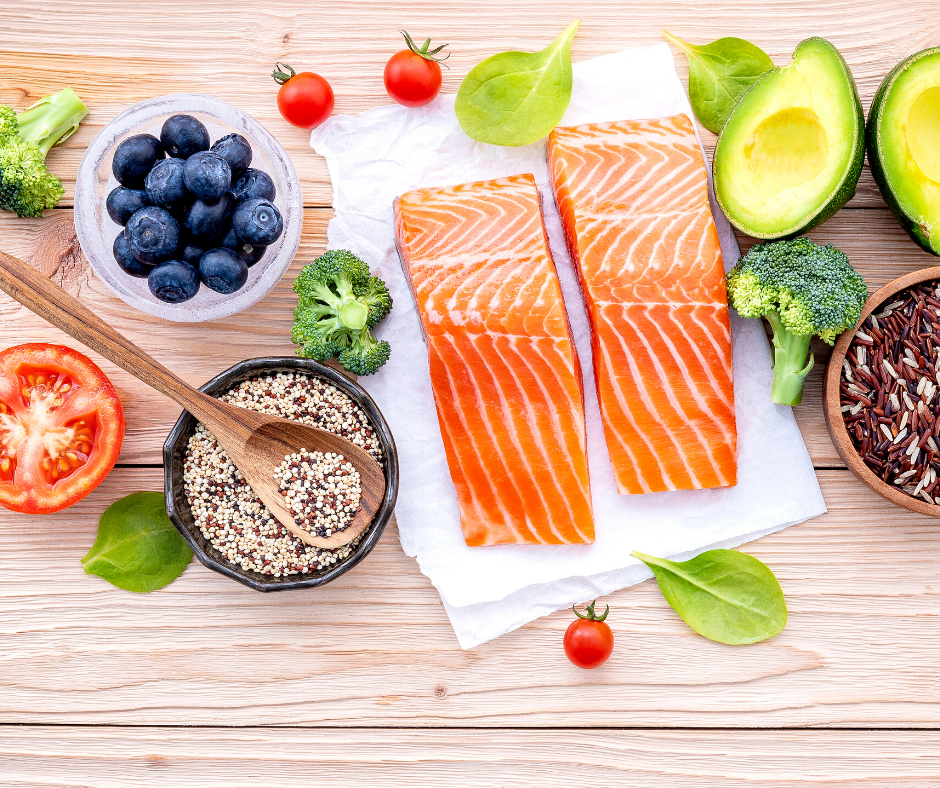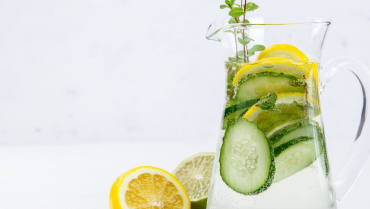Once you’ve listened to the symptoms your body is using to tell you it needs some detoxification, it’s time to change your diet to include foods that support it.
The goal of a clinically-directed detoxification plan is to provide nutritional support for the pathways involved in the processing and elimination of toxins. This results in improved symptoms and an increased sense of overall wellbeing. A boost in energy, clarity of mind, reduced pain, and inflammation, better sleep, and even weight loss, are the top improvements.
We’re here if you want help with your detox program. To begin changing your eating habits now, follow these guidelines.
What not to eat for detox.
Avoid these significant food triggers that cause inflammation:
- Eggs
- Gluten
- Soy
- Corn
- Peanuts
Additionally, a beneficial part of a detox plan is to build awareness of personal food triggers so you can reduce your immune responses to foods.
Clean eating is important.
When you do your detox, place a strong emphasis on clean eating — reducing food contact with plastics, and eating organic and free-range whenever possible.
Therapeutic foods for detoxification.
There are specific foods that support organs in the elimination of toxins. Taurine, Methionine, and Glycine are just a few amino acids that are huge in detoxification, and therefore high-quality protein is essential for efficiency and effectiveness.
Therapeutic proteins include:
- Free-range and grass-fed beef, chicken, and turkey.
- Wild-caught fish, including anchovy, herring, mackerel, rainbow trout, salmon, sardines, etc.
- Nuts and seeds, including ground flaxseed, hemp seeds, almonds, walnuts, etc.
- Clean protein powders – hemp, pea, and rice.
Antioxidants are also crucial as they protect cells. You can be sure to get these antioxidants by filling your plate with lots of colors – eat the rainbow!
Therapeutic fruits include:
- Apples
- Blackberries
- Blueberries
- Cherries
- Grapes
- Grapefruit
- Mandarins
- Oranges
- Raspberries
- Strawberries
Therapeutic Vegetables include:
- Arugula
- Broccoli
- Broccolini
- Cabbage
- Cauliflower
- Radishes
- Bok Choy
- Swiss chard
- Cilantro
- Dandelion greens
- Kale
- Parsley
- Chives
- Garlic
- Leeks
- Onions
- Scallions
- Shallots
- Artichoke
- Asparagus
- Beets
- Celery
Therapeutic grains include:
- Rolled or steel-cut oats
- Quinoa
- Millet
- Buckwheat
Therapeutic fats include:
- Nuts and Seeds
- Avocado
- Ghee
- Coconut oil
- Extra virgin olive oil
- Flaxseed oil
- Hempseed oil
Therapeutic herbs and spices include:
- Curry
- Dill
- Ginger
- Rosemary
- Turmeric
Many herbal teas can support the body in detoxification and digestion like dandelion tea after meals. See our post here for guidance.
For guidance on how to build a healthy meal, check out this post.
Here are some of my favorite detox recipes:
Spring Detox Soup
Total time: 40 minutes
Yield: 6-8 servings
Ingredients
1 TBSP olive oil
1 medium yellow onion, diced
1 large carrot, peeled and chopped
2 celery stalks, chopped
4 garlic cloves, minced
1-2 cups asparagus, cut into 1 inch pieces
1 cup mushroom, diced (those with SIBO/Candida omit)
1 medium tomato, diced
4 cups vegetable stock (or you can use the Magic Mineral Broth recipe)
1 1/2 tsp dried oregano
1 tsp dried basil
1/2 tsp dried thyme
1 tsp sea salt
1/2 tsp black pepper
4 cups of baby spinach, stemmed and chopped
2 TBSP fresh parsley, chopped
Instructions
Heat up a large pot over med-high heat and add olive oil. Throw in onion, carrot, and celery and cook for 3-5 minutes or until onions are translucent. Add in garlic and cook for 1 minute. Add in asparagus and cook for another minute. Add tomato, mushroom, vegetable broth, and spices and give it a stir.
Bring to a boil and then let simmer, uncovered over med-low heat for 25 minutes.
Add in baby spinach and cook for 3-5 more minutes or until wilted. Top with fresh parsley and serve warm.
Tips
This soup will keep in the refrigerator for a week making it a quick and easy daily meal throughout your detox program. You can also freeze it for several months.
You can really make it your own with whichever vegetables you have in the refrigerator. I have added artichoke hearts, baby kale, green beans, red, yellow, and green peppers, etc.
You can add shredded chicken/turkey for extra protein as well. Always choose organic, free-range when possible.
Magic Mineral Broth
Prep time: 10 minutes
Cook time: 2-4 hours
Makes 6 quarts
Ingredients
6 unpeeled carrots, cut into thirds
2 unpeeled yellow onions, cut into chunks
1 leek, white and green parts, cut into thirds
1 bunch celery, including the heart, cut into thirds
4 unpeeled red potatoes, quartered
2 unpeeled Japanese or regular sweet potatoes, quartered
1 unpeeled garnet yam, quartered
5 unpeeled cloves garlic, halved
1/2 bunch fresh flat-leaf parsley
1 (8-inch) strip of kombu*
12 black peppercorns
4 whole allspice or juniper berries
2 bay leaves
8 quarts cold, filtered water
1 tsp sea salt
*Kombu is a mineral-rich seaweed (in the kelp family) that adds an umami or savory flavor to stocks and broths. Kombu is usually found in the Asian section of a grocery store near the nori (seaweed sheets) that are used for sushi. Store dried Kombu in a cool, dark area in your pantry.
Instructions
Rinse all of the vegetables well, including the kombu. In a 12-quart or larger stockpot, combine the carrots, onions, leek, celery, potatoes, sweet potatoes, yam, garlic, parsley, kombu, peppercorns, allspice berries, and bay leaves. Fill the pot with the water to 2 inches below the rim, cover, and bring to a boil.
Remove the lid, decrease the heat to low, and simmer, uncovered, for at least 2 hours. As the broth simmers, some of the water will evaporate; add more if the vegetables begin to peek out. Simmer until the full richness of the vegetables can be tasted.
Strain the broth through a large, coarse-mesh sieve (remember to use a heat-resistant container underneath), then add salt to taste.
Let cool to room temperature before refrigerating or freezing.
Storage: Store in an airtight container in the refrigerator for 5 to 7 days or in the freezer for 4 months.
Per Serving: Calories: 45; Total Fat: 0 g (0 g saturated, 0 g monounsaturated);
Carbohydrates: 11 g; Protein: 1 g; Fiber: 2 g; Sodium: 140 mg
Reprinted from The Cancer-Fighting Kitchen: Nourishing, Big-Flavor Recipes for Cancer Treatment and Recovery. Copyright © 2009 by Rebecca Katz with Mat Edelson, Ten Speed Press, a division of the Crown Publishing Group, Berkeley, CA.
Detox Smoothie
Ingredients
1/2 cup mixed frozen berries
1-2 TBSP black raspberry nutritional powder (e.g., Botanic Innovations and other brands) or powdered greens (Paleo Greens by Designs for Health or Spirulina powder)
1 cup dark, leafy greens (e.g., arugula, broccoli leaves, collard greens, baby kale, baby spinach, watercress, etc.)
2-3 ounces carrot juice
4 ounces green tea
3 ounces low sodium tomato juice
Water, for taste and texture
Instructions
Place all ingredients into a high-powered blender or NutriBullet until desired consistency is reached.
Inflammation-Control Smoothie
Ingredients:
1/2 cup blackberries or black raspberries
1/2 cup citrus or tropical fruit (e.g., tangerine, orange, mandarin, papaya, mango, guava, apricot, nectarine, etc.)
1 large collard green leaf
1/2-inch knob ginger root, fresh
¼ – ½ cup baby kale or spinach
1/2 cup pomegranate seeds (or 2 ounces pomegranate juice)
1-inch knob turmeric root, fresh (or 1/2 teaspoon ground turmeric)
Water, for taste and texture
Instructions
Place all ingredients into a high-powered blender or NutriBullet and blend until desired consistency is reached.
Now is the right time to begin cleaning up your diet and supporting your body’s detoxification process. BeWell Associates can help guide you through the detox process and set up an individualized plan for you.





Add Comment